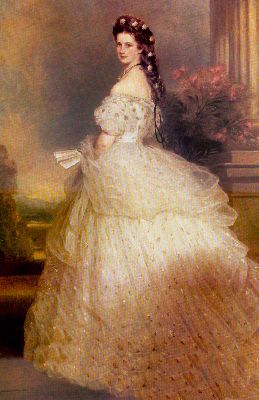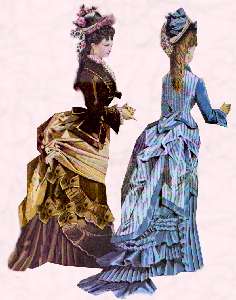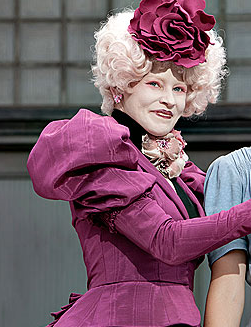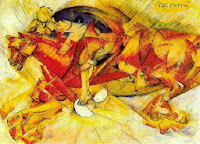Film Inspiration: The Hunger Games
My concept for the visual product is of a headpiece that is inspired from the Victorian era and Steampunk. When I saw the first film from the trilogy of The Hunger Games I fell in love with the edgy and eccentric costumes especially of Effie Trinket's character who she wear outrageous outfits at all times. I chose these to two styles of Victorian and Steampunk because steampunk is inspired from Victorian and the film portrays steampunk a lot especially when it comes to fashion and technology.
Victorian Era Fashion
 |
| Crinoline skirt flatted from front. Winterhalter painting, 1865 |
When Queen Victoria reigned in England she was still very young just 18 years old so she was adventurous,creative, innovative and fearless to try out new things. During the period she reigned, fashion was launched that would be an inspiration and phenomenon till present. Basically the Victorian era was split up into two periods early period ( 1837-1860 ) and the mid-to-late period ( 1860-1901 ).
Before the Victorian era dresses were much elaborate and huge, in fact they used to wear a crinolines under the skirt to make it look fuller, these were like cages . The sleeves were puffed and created broad shoulders. When the Victorian era developed, dresses by time started to become much more practical and narrower sleeves, tight-fitting boned bodice, narrower skirts with ruffles and frills. In the mid-Victorian era (1860-1880) the sewing machine was invented, fashion became more couture design, synthetic dyes were available for intense colours and the crinoline skirt was flattened in the front but showed the garment from the back.
Before the Victorian era dresses were much elaborate and huge, in fact they used to wear a crinolines under the skirt to make it look fuller, these were like cages . The sleeves were puffed and created broad shoulders. When the Victorian era developed, dresses by time started to become much more practical and narrower sleeves, tight-fitting boned bodice, narrower skirts with ruffles and frills. In the mid-Victorian era (1860-1880) the sewing machine was invented, fashion became more couture design, synthetic dyes were available for intense colours and the crinoline skirt was flattened in the front but showed the garment from the back.
 |
| Soft polonaise bustle. |
In 1875, they were in vogue the soft polonaise bustle this was a draped and frilled train at the back of a dress.With the invention of the sewing machine it made easier to add frills, pleats, ruffles braids and fringing and made it heavily ornamented until later were replaced by the Princess sheath garment. By 1880 the silhouette was getting longer ans slimmer even more by the train. These lasted for three years only though. Followed by in 1883 the hard bustle which made the women's silhouette look like the hind legs of a horse.
 |
| Tailored made suits of the 1890's |
Tailored made garments were introduced in 1874 that led to fashionable tailor made suits in the 1890's . Fashion now became more plain, simpler and tailored yet still elegant and neat.Sharp tailored jackets were popular and embraced by the late Victorian women, it made more confident and a different posture. Women were showing their strength as a gender in their workplace with Power Dressing, which was similar in 1985, through women wearing masculine tailored and shoulder padded jackets.
The gowns of the 1880's were made from two colours and one material, colours usually were vivid such purple, royal blue, deep red, peacock blue, bright green and many more sometimes the combinations were rather strange. In contrary to day dresses the night gowns were made in softer hues and contrasting fabrics.
The incorporation of details such lace, tulle, corsets, slim-fitted gowns and extravagant headpieces will attract the youth generation. Its a way of keeping the historical Victorian era fashion alive by combining the traditional of the nineteenth century with modern fashion.
Modern Fashion Inspired from Victorian Era
Although its been over a 100 years since Victorian era fashion was developed, it remained a phenomenon and an influence with modern fashion designers and society. Famously worldwide fashion designer used Victorian styles in their haute couture collection,ready-to-wear collections,editorials even for wedding gowns. Making a good observation one can notice the influence of Victorian fashion in fairy tale themed shoots, Gothic editorials and in movies such as The Hunger Games, Marie Antoinette, Alice in Wonderland, Sweeney Todd amongst many others. Detailed pieces such as lace, ruffles, frills, tulle and many more add that beautiful and elegant touch to modern collection.
 |
| Atelier Versace Spring 2011, |
 |
| Bridal Collection, Yolan Cris Spring 2013 |
Effie Trinket- The Hunger Games
As I mentioned in the beginning my main inspirations for the visual concept the headpiece is Effie Trinket, one of the main character in the Th Hunger Games trilogy who she has the role of an escort in district 12. I fell in love with the costumes that Trish Summerville created for the cast especially for Trinket. Trish Summerville is the costume designer for this trilogy, she confessed that her main inspiration for Effie Trinket's outfits were Marie Antoinette and Italian fashion designer Elsa Schiaparelli.Summerville wanted to create something silly and fun for Effie. Trinket's was considered as a style icon in the Capitol city, she is an eccentric with a unique and flamboyant outfits and always changing stylized wigs and make-up.Her character is one of a perfectionist and always prim and proper and hate bad manners, this qualities reflect in her outrageous outfits that are always matching, sophisticated, and neat. The Victorian influence can be seen in her outfits very clearly such as the tailored suit with puffed sleeves, ruffles, extravagant headpieces, tulle, wide skirts or dresses, vivid or pastel colours, flower patterns, collars and even permed coloured hair.
| The poster for Catching Fire |
 |
| Effie Trinket |
 |
| Wearing a tailored made suit. |
Thomas.,P, 2001-2013. Early Victorian Costume and Fashion History 1837-1860. [online] Available at: <http://www.fashion-era.com/early_victorian_fashion.htm >
[Accessed 18 December 2013]
Thomas.,P, 2001-2013. Mid-late Victorian Fashion and Costume History 1860-1901. [online] Available at: < http://www.fashion-era.com/mid-late_victorian_fashion.htm >
[Accessed 18 December 2013]
Trend Hunter Inc,n.d. 100 Victorian Inspired Styles.[online] Available at: < http://www.trendhunter.com/slideshow/victorianinspired-styles >
[Accessed 19 December 2013]
Trend Hunter Inc,n.d. 100 Victorian Inspired Styles.[online] Available at: < http://www.trendhunter.com/slideshow/victorianinspired-styles >
[Accessed 19 December 2013]



































